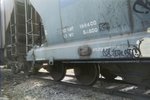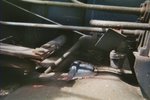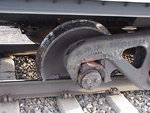syscom3
Pacific Historian
A friend of mine just sent me these pictures of a "truck" problem on a hopper car.
Can you imagine the noise that was made?
text is:
"These photos were sent to me of a hopper car somewhere between Liberal and Pratt, Ks that had lost both side frames, springs, everything and still did not derail. The UP train set it out to await repairs. In the second photo, you can see where the wheel rubbed through the floor plate. I don't have a date but I think it was within the last 3 or 4 months."
Can you imagine the noise that was made?
text is:
"These photos were sent to me of a hopper car somewhere between Liberal and Pratt, Ks that had lost both side frames, springs, everything and still did not derail. The UP train set it out to await repairs. In the second photo, you can see where the wheel rubbed through the floor plate. I don't have a date but I think it was within the last 3 or 4 months."



